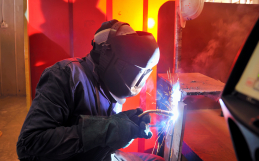When metal fabricators are working on a project, there are four methods at their disposal: bending, cutting, stretching and shrinking. Here are the common techniques used to get the work done:
1. Bending Metal
Form bending: The easiest way for fabricators to bend metal is through form bending, which is done by bending the metal over a shape or an edge with a hammer.
Metal brake: This is the most common technique used for precise metal bending. In this technique, the metal is placed on a flat, gated surface with a flat bar clamped on top of the metal and lifting the gated portion to bend the metal to the angle desired.
2. Cutting Metal
Hand shears: Also called aviation snips, hand shears are used to manually cut metal. It’s considered one of the first tools metal fabricators should have in their arsenal.
Power shears: These tools allow you to cut sheet metal quickly and with less effort than hand shears. Power shears come in many forms, including pneumatic and electric shears. Most of them are not capable of cutting around tight corners or complex shapes, and will usually waste material.
Throatless shears: Some throatless shears are able to cut tight radii. They are designed to cut straight lines or shapes in metal without marring edges. Throatless shears are operated by hand and do not waste material.
Angle grinders: An electric angle grinder is a handheld tool that spins an attached disc or wheel to cut metal.
Plasma cutters: When adjusted properly, a plasma cutter can cut sheet metal quickly while still maintaining a high level of accuracy. They are great for making long straight cuts and require very little clean up.
3. Shrinking Metal
Tucking metal: One of the earliest ways to shrink metal, tucking metal bunches the metal with a hammer and form.
Shrinker: This tool is operated with a lever by either hand or foot. It has moving, textured jaws that grab sheet metal from the top and bottom, forcing it together. Using a shrinker is more precise than tucking metal and leaves minimal marring.
Heat shrinking: Fabricators heat an area that is overstretched with a torch that shrinks when it cools.
4. Stretching Metal
Hammer and dolly: With this method, you hold an object behind the metal and hit the opposite side with a hammer, which causes the metal to increase in surface area and ultimately stretch. Metal can also be stretched in a similar method by using a sandbag and plastic mallets to quickly stretch metal and make shapes.
Stretcher: The opposite of the aforementioned shrinker, a stretcher is a mechanically-operated tool that slowly pulls the metal apart when a lever or foot pedal is pressed.
English wheel: This metalworking tool works like an anvil to stretch metal, with the ability of creating compound curves. The metal is placed between a flat-faced upper wheel and a lower anvil with a small radius. An English wheel can also be used to smooth out imperfections in the metal.
Looking for metal fabricators who can handle your large-scale commercial job? Contact our experts at CE Metal. With years of industry experience, we offer the highest quality service and a product that speaks for itself.





